Photos by Kip Miller
There is
a hugely popular island in the Ionian Sea that is a cultural mix unlike
any other. Corfu (or Kérkyra, as the Greeks call it) has a pronounced
Venetian, English, and even a little French air about it. Even more remarkable
is how these European influences are seamlessly integrated into the local
Greek culture. The result is a unique, hybrid personality that offers
something for everyone.
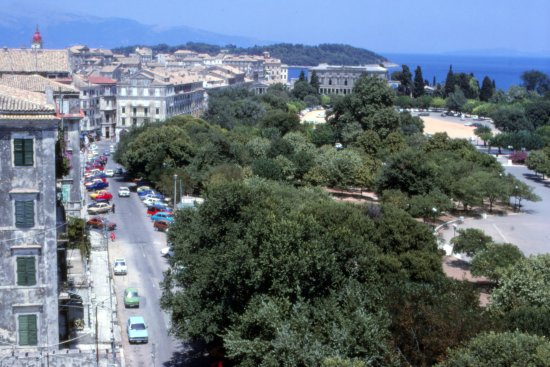
Corfu’s huge esplanade (Spianáda) fronts the old Venetian town.
Corfu’s uniqueness appeals to us also. It is May 1983, a year marked
by the loss of my father and a year that we plan to take our children
and my mother on a restorative getaway. However, a month is a long time
to stay in a hotel and we genuinely want to experience authentic Greek
life, hybrid or not.
Fortunately, we have a good friend in Athens who is knowledgeable and connected. After a few quick calls, he puts us in touch with Christóforos Lavrános, a well-mannered islander who owns a stately English townhouse in Corfu town with a third floor apartment that he rents to visitors. The pictures of the flat are impressive. Delighted, we sign up for the entire month of July.
Six weeks later, with five suitcases jam-packed for all eventualities, we depart Athens on the hour-long fight to Corfu due to arrive before noon. Below us, this greenest of all Greek islands is densely covered with silvery olive groves, a legacy of its 400-year Venetian occupation. When the Doges took possession of Corfu, they realized the local population needed to produce something of value for the empire. The Greeks were paid ten gold ducats for every hundred olive trees planted and soon a family’s wealth could be measured by numbers of trees and quantities of oil produced. There are nearly four million olive trees thriving in Corfu today, clearly benefitting from its substantial winter rains. Some gnarled specimens are more than 600 years old!
Corfu is part of the Eptánisa, the seven Ionian Islands that were never (other than Lefkáda) under Turkish occupation like the rest of Greece. As our taxi approaches the city, we are immediately taken by its cosmopolitan appearance: an imposing Venetian-like citadel, more like a cousin of Dubrovnik. Those who arrive by sea are welcomed by two massive forts, one older with crumbling sea walls, the second a century newer. The old fort area leads to a vast grassy esplanade (Spianáda) edged by a park area where cricket is played regularly, a custom dating back to Corfu’s 50 years as a British protectorate, ending in 1864 when Queen Victoria ceded the island the newly independent Greek republic. Our driver asks if we have ever played cricket or tasted tsintsibírra, a beverage of British origin made with herbs and ginger. “Ah, this you have to try,” he adds with insider authority.
We turn into
Moustoxídi Street where Mr. Lavrános awaits us. The townhouse
is nearly two hundred years old, dating from the beginning of the British
era. It is elegant and formal and crammed with antiques and family heirlooms.
“Call me Chris,” says Lavrános, a gracious, refined gentleman
whose family history on the island goes back hundreds of years. “Before
returning to my home here, I lived in South Africa for many years and
that is where I met my late wife. She was an Irish writer. That’s
her portrait over the piano,” Chris is quick to reveal. “I hear
that you are very fond of Greece. I am so happy you came to Corfu.”
He directs us to the third floor and we haul our luggage up. The space
is wonderful, comprising a large sitting room with several beds, a bedroom
alcove with two more beds, and a huge kitchen with a bathtub on one side.
The toilet is in its own room and what a toilet! It is hand-painted and
as fine as a Chinese porcelain vase. “I have to caution you, it does
not have a flush mechanism. You have to fill this large pitcher with water,
pour it in the tank above and let gravity do the work,” explains
Chris. “Never mind,” we smile, “if the English could handle
it, so can we!” We poke around the refrigerator and find it already
stocked with Danish butter, eggs and a few other essentials. Chris thinks
of everything.
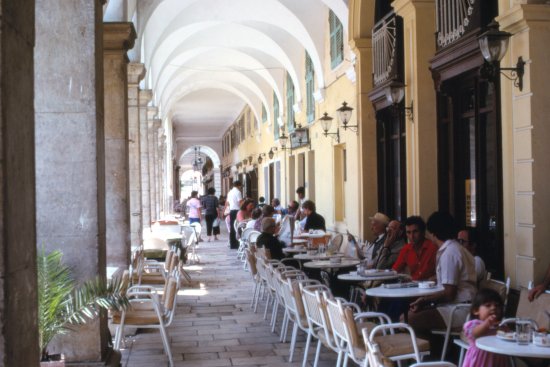
Resembling Paris’s Rue de Rivoli, The Listón is an arcaded street filled with elegant kafenía.
Not bothering to unpack, we rush down the Spianáda to the Listón, an arcaded street that was commissioned by Napoleon during the brief French period and bearing a striking resemblance to the Rue de Rivoli. Here one finds the priciest coffee houses on the island and very elegant shops. During its heyday, only aristocrats inscribed in the local social registry were permitted to stroll here. “This isn’t Paris, but close,” I decide. At the foot of the Listón sits the grand Palace of St. Michael and St. George, the oldest official building in Greece, now housing one of the world’s finest collections of Asian art.
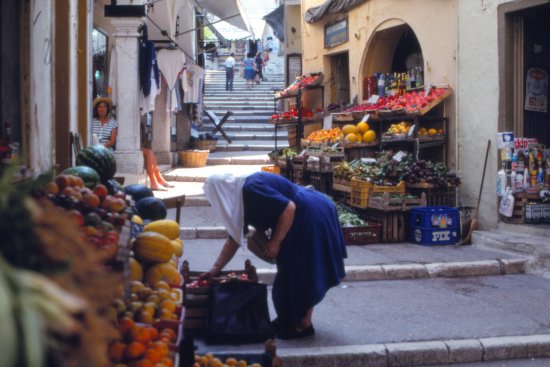
A local yiayiá (grandma) selects fruits on one of the old town’s stepped kantoúnia.
The town is bustling with shoppers headed home to rest after their leisurely
mid-day meal. Beyond the Listón, narrow cobbled lanes (kantoúnia)
are crammed with small boutiques, green grocers, butcher shops and restaurants.
Our nine-year-old son, Jeremy, devours his first ice cream cone. He will
consume dozens of “number one” cones during the month, invariably
choosing ice cream over local Greek cooking. Our daughter, Alison, just
shy of 13, is visibly excited, realizing that she and Jeremy will be able
to wander around on their own once they familiarize themselves with the
streets. Even my mother has a gleam in her eye. Lithuanian-born, she practically
swoons as we pass by an enticing bakery, taking in a whiff of yeast and
cinnamon: “Ahh, just like the old country. Isn’t it wonderful?”
After a restorative siesta, a ritual we adopt on our very first day, we
wander off at dusk to a cozy psitopouleío (grill house) that Chris
recommends and share spit-roasted chicken and tzatzíki (or schmeer,
as my mother calls it). Above our heads hang the owner’s sheets and
towels, still damp from a recent wash. I am tickled that we are the only
tourists in the place; the patrons are all neighborhood locals.
Sleeping
on the third floor away from the street noise works out well, except for
grandma’s melodious snoring that rises and ebbs throughout the night.
We discover a large fan in a corner that helps to mask the night noise.
The sun streams in, awakening us, and we embark on a shopping spree before
breakfast that will become a daily ritual: chatting with farmers at a
nearby outdoor market as we select fresh fruits and vegetables, buying
two crusty loaves hot out of the oven at the bakery down the street, or
tangy spinach pitas made fresh every morning in a teensy shop. After a
few days, all of us are fairly self-sufficient, even the kids, to do the
shopping on our own On the third day, Grandma comes in with a large bag
of juicy peaches and tomatoes, laughing and smiling. “I’m a
Greek yiayiá (grandma) now,” she says. One day I follow her
as she squeezes produce and tries to communicate with the vendors and
I can see that, except for language, she can pass for a Greek.
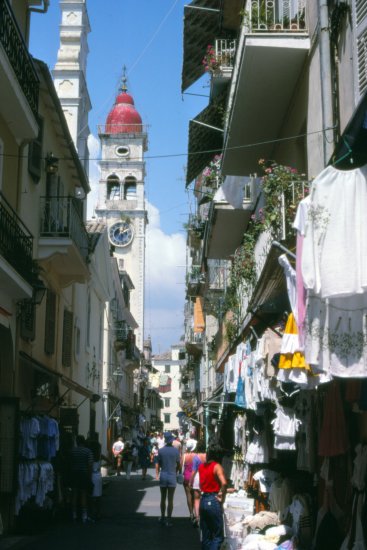
St. Spyrídon towers above a busy Corfu lane.
And so begins our blissful month in Corfu. We venture out to the major
churches and monuments. At St. Spyrídon, the church of the island’s
patron saint with its towering bell tower, we walk down the central aisle
to the spot where a silver coffin holds his mummified remains. Spyrídon
is venerated because he reputedly saved the Corfiots from several major
calamities. I mention to my husband that “nearly half the men on
the island are named Spyros after the saint,” a bit too loudly I’m
embarrassed to say, as several men turn their heads to see who is speaking
to them.
We get to know the merchants at our favorite shops: the aromatic olive wood store, the boutique with hand-painted sea pebbles, the copper antiquarian, the dusty handicraft shop where we discover a beautiful platter from Skyros, the coffee roaster, sweet shops bursting with nougat confections, and several booksellers with plenty of English titles. The shops seem never-ending and as the weeks roll by, we continually discover new ones. Jeremy, of course, becomes the family specialist in gelaterias and kiosks with ice cream freezers. By the time we leave the island, I think they all know him by name.
The oldest
part of town, behind the new fort, includes the historic Jewish ghetto
area, not far from Plateía Solomóu, a square dedicated to
the national poet of Greece. Here we find Corfu’s only remaining
synagogue, the gable-roofed Scuola Greca on Velissáriou Street,
built in the 18th century in Venetian style. Of Corfu’s once sizable
Jewish community, decimated by the Holocaust, only about 60 people remain
and a rabbi has to be brought in each year for the High Holidays. I am
told that a few of them still speak “Italkian,” a mixture of
Hebrew, Italian and Greek that was the lingua franca of the ghetto.
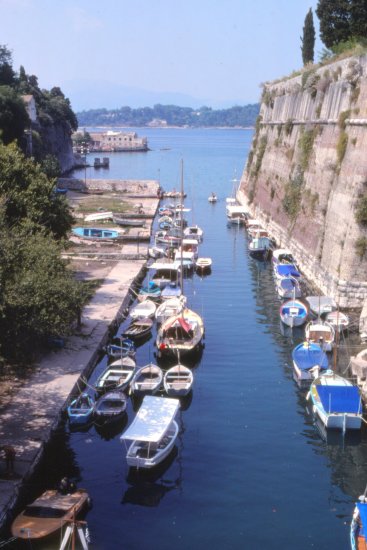
The contrafóssa is a picturresque, narrow channel separating the old fort from Corfu town.
One especially lovely day, we explore the old fort promontory, crossing
over a bridge from the Spianáda. The site was heavily degraded
during the British era, but today has been repurposed for sound and light
shows and performances. A small gate house delights visitors with its
unusual mosaics and frescoes. The view of the contrafóssa, the
canal that separates the fort from the city, is much photographed and
we are asked repeatedly by other tourists to take their picture. The town
of Corfu gleams like a jewel before us, but the Greek mainland and the
barren Albanian mountains to the north appear grim and grey across the
channel. At the edge of the old town the new fort rises. Built in 1576,
it was once protected by 700 cannons that were instrumental in repelling
several sieges by the Ottomans. The Corfiots’ successful defense
was due in large part to the bravery and genius of a German soldier of
fortune, Field Marshal Schulenberg, whose statue commands a place of honor
at the edge of the Spianáda
Living in a paradise infused with Greece’s magical light motivates us to explore. To the south of the our neighborhood, near the coastal road, we are drawn to Corfu’s impressive archaeological museum, famed for its large archaic pediment of Medusa, mother of the Gorgons and as sacred to the Corinthians in the sixth century B.C. as St. Spyrídon was in Byzantium and still is today. I stare at her bulging eyes, wicked smile, and snake hair and wonder how this bizarre head was sliced off by Perseus. Corfu’s legends date back to the mists of time and remnants of its star-studded past are evocatively displayed. As the centuries rolled by, an impressive list of historical and literary notables crossed its shores: Caesar, Antony and Cleopatra, Richard the Lion Hearted, Lord Byron, Lawrence and Gerald Durrell, Henry Miller, to name just a few. Shakespeare sited The Tempest in Corfu, and Homer’s Odysseus met the lovely Naúsicaa here. Truth be told, Corfu rivals Athens as a center of higher learning and music. Fully three-quarters of all the musicians in the Athens Philharmonic today come from the island, and the very first university in Greece was founded here, not to mention its first financial institution, The Ionian Bank of Greece.
On our first
Saturday night, we walk past a beautiful Baroque building with all its
windows wide open, allowing the sounds of flutes, oboes and bassoons immersed
in rehearsal inside to permeate the surrounding streets. The next afternoon,
we find the Spianáda throbbing with activity as a small coterie
of musicians with wind instruments seated inside an ornate music pavilion
play to an enthusiastic crowd. The entire esplanade is crowded with Corfiots
dressed in their Sunday best, strolling up and down in a kind of Greek
courtship ritual, the vólta. They look like plumed peacocks in
search of a mate, or gilded housewives showing off the latest jewels and
fashions. And as they stroll, all the young men try to catch the eye of
the prettiest island girl while older gentlemen cast discrete sideways
glances at the matrons. You can go to any town in Greece and see some
version the vólta, but here in Corfu it has evolved into high art.
By six or seven in the evening, the locals move on to sweet shops and
indulge, lingering and gossiping over their coffees, and then strolling
again before dinner around nine or ten. Jeremy does not understand why
“Greeks have dessert before they have dinner,” but he thinks
it’s a great idea!
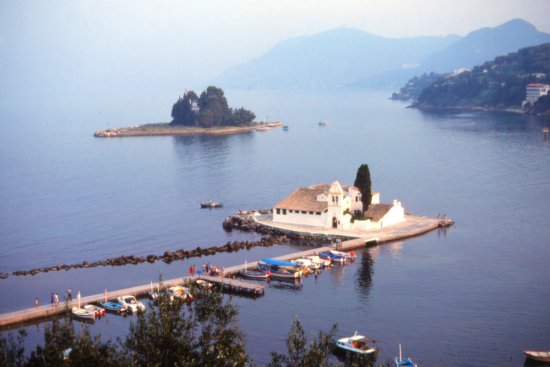
One of Corfu’s iconic vistas: Vlahérna monastery with little mouse island beyond.
Starting out extra early one Tuesday, we hike a few kilometers to Mon
Repos, the birthplace of Prince Phillip, the Duke of Edinburgh. Built
by the British in 1824 atop the site of ancient Palaiópolis, it
is an elegant Regency palace surrounded by a 250 acre woodland park near
the sea. We have to restrain the kids from running loose in its maze of
walkways. Gardens exude bouquets all around us and the air is soothing
and seductive. Corfu is famed for its profusion of plants: While olive
trees predominate, the island also has abundant kumquat, fig and almond
trees, pencil thin black cedars, and endless varieties of wildflowers,
including 43 types of native orchids that thrive in its subtropical climate.
Continuing south for about three kilometers on the coastal road to Kanóni,
we catch a glimpse of two islets: The larger is Vlahérna, with
its lovely monastery, the smaller Pontikoníssi, or Mouse Island,
its miniscule chapel linked by a staircase that looks like the tail of
a mouse. Of all the picture spots on the island, this is clearly number
one. Tired and ravenous after the long walk, we take the recommendation
of a local and find a shady table under the trellises at Nausicaa, a garden
restaurant in Kanóni. Grapes clustered above our heads are not
destined to ripen until late summer. “Pity we will be gone by then,”
I say with longing.
By now the kids have had it with sightseeing and want to swim in the sea. Aside from one local beach within walking distance of our flat, we have yet to explore dozens more on the island. Getting around Corfu is easy and the central bus station is jammed with buses setting out in all directions. One warm morning we choose the bus headed to Kávos, a shallow beach on the very southern tip of the Corfu. The bus winds through well tended vineyards, old country estates, and olive orchards that become noticeably sparser as we head south. At Lefkími, the last village before the sea, several women wearing traditional headscarves smile from their stoops as we wave from the bus. Kávos is overcrowded with run-of-the-mill tourist villages that sprawl on the beachfront, but fine sand stretches out to the warm sea for a couple of hundred meters, deepening very gradually, making it ideal for children. I can hear the kids laughing and splashing as we loll under umbrellas, gentle breezes keeping us continuously refreshed.
On another beach day our bus heads out on the scenic coastal road north of the capital, through the upscale resort of Ípsos, to Nissáki, a beach just above Barbáti. Here one can dive into a deep sea off the rocks and then feast on kalamária in any of several nearby fish tavernas. Continuing north, we gaze at tiny fishing villages, hills dense with myrtles, and terraced fields of cacti and wild herbs that seem to spill right into the azure sea. Through my open bus window I smell lavender and rosemary. I can see lizards darting out of roadside rocks and caterpillars hanging from threads on several trees.
Soon we reach bustling Kassiópi, a village dating back to Hellenistic and Roman times. Tiberius once lounged at a villa here and I am reminded this is also Durrell country, their white house nestled on seaside rocks in nearby Kalámi. Across the channel, only a few kilometers away, Albania’s arid mountains rise moon-like, untouched by our earthly paradise. We stop at a pretty taverna in the harbor area where boats depart for day trips to the capital. Our lunch of moussaká and salad seems exceptional, accompanied by cicada song rising from the distant hills and the scent of jasmine wafting from flower pots.
Swim days generate wet towels, suits and piles of laundry, forcing us to schedule a major laundry day. My husband fills the bathtub with sudsy Tide water and we spend a couple of hours soaking and scrubbing away, the radio blaring rhythmic Greek bouzóuki music to help motivate us. Grandma stops to inspect our underwear, ready to be hung out by an open window. “Could be whiter!” she declares. We decide to let her take charge from here on. With half a day left, we escape to the oldest part of town near the port. Starting at the sea walls below the fort, we wind down Arseníou Street, past some of the finest Venetian buildings in town and a lovely sea view of the islet of Vídos. We are steps away from the Campiello, a warren of narrow streets with houses so close they nearly touch each other. Overhead, a riot of laundry is strung out, creating a shady canopy, and I wonder if Corfiots know something we don’t know about wash day.
Appetites piqued by dozens of eateries serving mid-days meals, we choose a table at Chrysomállis, a traditional restaurant that the Durrell brothers frequented during the 1930s. The menu is decidedly more Italian and we sample spaghetti with mussels and brodétto (Venetian-style fish soup). Nearby, an arty bar housed under medieval arches features fragrant bean soup, house-made pasta, olive bread and locally brewed ale, a good bet for another day’s feast. We tell the solicitous waiter we have already eaten. “Tha páte ávrio, étsi (you’ll come tomorrow, it’s decided), he waves his hands in the air with conviction.
About two
weeks into our stay we get word that our Chicago friend Hannah and her
three teenagers are due to arrive for a short visit. They check into a
charming old hotel near our flat with views to the sea. It’s wonderful
to see long-time friends and we compare travel adventures over mid morning
coffee and croissants. That’s not enough nourishment for growing
boys. Jordan and Evan complain they are still hungry. “Follow me,”
says Alison without missing a beat, heading off to her favorite gyro stand
where crispy fries are packed right into the pita bread along with juicy
slivers of lamb and tzatzíki, a value meal per drachma spent. Shopaholic
Hannah and daughter Lily wander off to the trendy boutiques in the Listón.
“Let’s meet in two hours,” yells Lily. Later, we sit on
benches by the cricket field for a brief orientation to the island. “Wouldn’t
it be fun to tour together?” says Hannah. We all agree and decide
to look into renting a van large enough to hold all nine of us. “Eímaste
oikoyénia tóra” (we’re family now), I announce
in my best Greek.
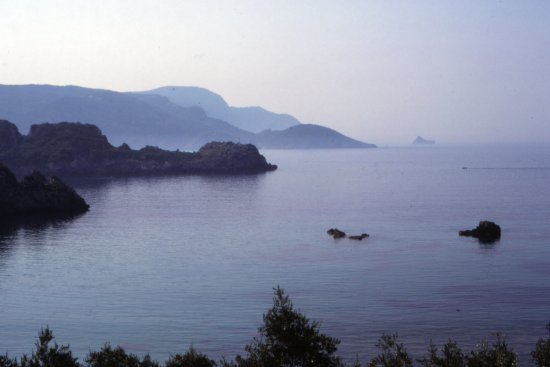
The ethereal seacoast of Paleokastrítsa is a locus of myths and legends.
A few days later, with Hannah at the wheel, our VW van climbs northwest
through dense olive groves chirping with grasshoppers, to Paleokastrítsa,
a splendid beach community with a string of bays on the western side of
Corfu. Not far from here naked Odysseus was swept ashore and welcomed
by King Alcínous and his lovely daughter Naúsicaa. All at
once the legendary sea appears ahead and we are stunned: “Wow!”
Paleokastrísta is more photogenic than any place we have ever seen
in Greece. The water is deep blue green, with sand and shale beaches framed
by wooded, jagged rocks that jut out to the sea. Fed by underground mountain
springs, the sea is cold and bracing. We spread our straw beach mats on
the sand and luxuriate. Grandma decides to dig and starts to pour sand
all over her body. At one point she is totally covered, except for her
head. “Are you turning into an ancient Greek relic for us to excavate?”
we tease.
Set on the highest hill above us with a sweeping view of the entire area is Panagía Paleokastrítsa, a fully functioning and much visited monastery dating back to the 13th century and restored 500 years later. Eight monks work the land and press olives when they are not greeting thousands of visitors. You can tour the sanctuary and also peek at their tiny sleeping quarters, each with a small balcony overlooking a flower-filled garden, and a small museum housing a large collection of icons. The monks are gracious as they lead us around, offering a sip of kumquat liqueur. I am convinced they are completely exhausted by the time the day’s last busload of tourists departs.
On our final driving day, we loop around Mount Pantocrátor, the highest point in Corfu, passing vibrant fields of Scotch broom and tiny settlements seemingly untouched by time, to the very northern tip of the island and the village of Sidári. Here, wind-carved sandstone cliffs hide secluded beaches such as the famous “channel of love.” “According to local lore,” an English tourist reads us a caption from her guidebook, “anyone who makes it through this narrow sea inlet is guaranteed everlasting love.” Although crowded with countless tavernas, bars and souvenir stands, the beaches are so lovely that we ignore the crowds and venture far afield to find solitude. The water is crystalline here and I am amazed by how many different types of beaches we have encountered so far on just one island.
One morning we board a crowded bus headed to the Achilleíon in Gastóuri, a summer palace built in 1890 by the melancholy princess Elisabeth of Austria, also known as Sissi. The neoclassic building is reputedly “overdone,” inspired by her romantic obsession with Achilles, hero of the Trojan War, and dedicated to the memory of her son, Rudolf, who died under mysterious circumstances. Sissi did not get to enjoy her creation for very long. Ten years later she was assassinated by an Italian anarchist and the Achilleíon became a summer getaway for Kaiser Wilhelm II. We are curious to see it, in spite of Henry Miller’s admonition that “it was the worst piece of gimcrackery that I have ever laid eyes on.” Upon closer inspection, the palace seems well suited for its current status as a gaudy casino. The gardens are quite lovely and there are several dramatic statues of Achilles. Jeremy has always been fascinated by Achilles and he rushes to pose in front of the largest statue for our camera.
Spending afternoons with Chris is becoming a favorite ritual and he is eager to share stories about life in the Ionian Islands, complete with colorful anecdotes. “You must go to Paxí,” he insists. “It is very beautiful.” The next morning, we board a tour boat jammed with daytrippers carrying swimming and snorkeling gear. After three hours at sea, we spot a remarkable turquoise beach straight ahead. The PA announcer blares in charming, garbled English: “Yes, please. Dive from boat. OK swim, but you back in 20 minutes!” We go for it. The water is deliciously refreshing, on the warm side, but heavenly. The sea bed is completely covered in pure white sand. No wonder the water refracts aquamarine! Passing by two islets, we pull into the capital, Gáïos, a small fishing port with faded Venetian buildings. The announcer explains how “Poseidon made Paxí rise from the sea so that he could have a special place, you know, ahem, to fool around with Amphitrite. She is sea nympho, but he makes her bride.” We explore the harbor area and head to a little museum packed with rustic furnishings and tools from centuries past. Numerous amphorae surrounding an ancient olive press look as if they have been there forever. I imagine myself dressed in a chiton waiting in line as my lekythós (oil flask) is filled with golden oil.
Music is intimately woven into the fabric of life in the capital: Three brass bands march on major holidays, operas and symphony orchestras play to packed houses, romantic serenades are sung under balconies and windows, chamber music ricochets off the alleyways of the Campiello, and small ensembles make surprise appearances throughout the city. But where can we hear traditional island music? At dusk one evening we travel by taxi to the nearby village of Koinopiástes, where a popular restaurant features folk entertainment. Trípas is a destination all by itself. Operated by the Anyfantis family since 1936, it has been frequented over the years by thousands of visitors, including celebrities such as Francois Mittterand, Aristotle Onassis and Jackie, Jane Fonda and Anthony Quinn. Inside, dusty shelves are crowded with hundreds of wine bottles and walls are jammed with photographs of famous patrons. Trípas is popular with Italians and Brits and several long tables fill quickly with rowdy tour groups. We enjoy the house mezédes (appetizers) and follow up with spit-roasted lamb. Several smiling musicians with guitars and mandolins take seats and tune-up. The floor show begins just as an overflowing platter of fruit reaches our table. Costumed teenagers perform kerkyraïkós, a flirtatious Corfiot couple dance, and then break into several other island dances, finally ending with typical taverna numbers seen all over Greece. The noise level is extremely high and the music is joyous. Everyone is having a raucous, good time. “Is it my imagination, or is the moon above winking approval?” I ask the kids as our taxi departs.
Music also travels to Corfu. One afternoon I notice signs plastered on walls and telephone polls announcing that Margarita Zorbalá will be appearing in concert in a couple of days at the outdoor theater in the fort. A popular singer with a big voice, she is a Russian-Greek from a large musical family recently immigrated to Greece. I have read that Zorbalá performs with composers Theodorákis and Hadjidákis, and even the great poet Yiannis Rítsos. She is also a featured singer in the just-released movie, “Rembétiko.” “Yes, tickets are still available,” says the man in the ticket booth, “póso thélete” (how many do you want)? On the chosen night we walk to the theater at twilight. The sky is streaked with high orange clouds filled with circling swallows. The sunset is especially dramatic as we take our seats on padded cushions. “A good omen,” I tell my husband. As expected, Zorbalá brings the house down and the audience keeps clamoring for more. I make a mental note to purchase some of her recordings in Athens.
Where has the month of July gone? It is our last night in Corfu and we realize how much we have grown to love this place. We saunter through the back streets of the Listón to Averof, an old restaurant on Proselendóu near the harbor known for traditional cooking. The very air here is tinged with the flavors of yesteryear. It’s our final chance to experience more of Corfu’s specialties. We find an empty table in the front and choose several popular island dishes to check off our list: savóuro (fried whitebait), sofríto (veal in a piquant tomato sauce) and pastisáda (made here with chicken in a spiced wine sauce served over pasta). At the end, the waiter surprises us with sikomáda: a refreshing blend of figs, nuts, and oranges. It’s a stretch for the kids, but they are willing to taste everything.
The next morning we wake up heavy-hearted. It is very hard to say good-bye. Chris gets a big hug from each of us, followed by a large box of chocolates from a patisserie in the Listón. “Efharistóume pára polí’ (thank you very much), I tell him. “You made it all possible, and we can’t thank you enough. We came as tourists, but we lived like Greeks!”
Alison and Jeremy wave to the city below as our plane rises in the air. “Will we ever be able to top our month in Corfu?” I wonder out loud, thinking about future trips. Then I remember what Durrell said, that the light in Greece is so pure and intense that everything here seems more vivid and real than any place else on earth. I smile, reassured. The radiant light will always be there for us. Greece will not disappoint.
